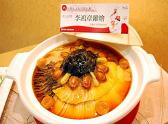| Li Hongzhang Hodge-Podge (李鸿章杂烩) A popular dish named after Anhui's Li Hongzhang, who was a top official of the late Qing Dynasty (1644-1911). The dish, a complex soup, is somewhat salty with a hint of sweetness. Many types of ingredients can be used in the dish but the most common include sea cucumber, fish, squid, bamboo, dry bean curd, chicken, ham, and assorted vegetables.
| 
|